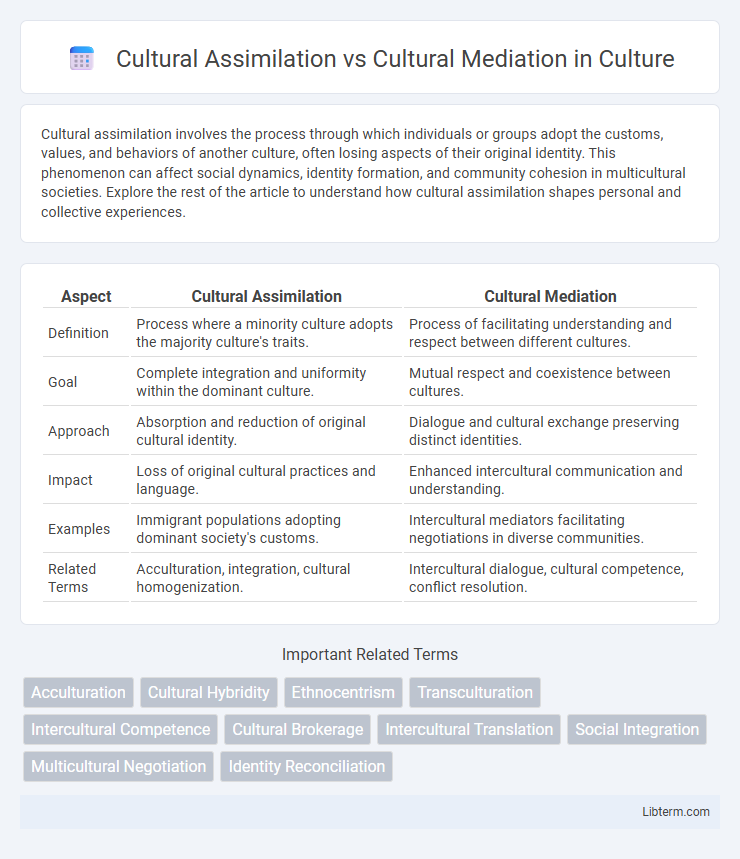Cultural assimilation involves the process through which individuals or groups adopt the customs, values, and behaviors of another culture, often losing aspects of their original identity. This phenomenon can affect social dynamics, identity formation, and community cohesion in multicultural societies. Explore the rest of the article to understand how cultural assimilation shapes personal and collective experiences.
Table of Comparison
| Aspect | Cultural Assimilation | Cultural Mediation |
|---|---|---|
| Definition | Process where a minority culture adopts the majority culture's traits. | Process of facilitating understanding and respect between different cultures. |
| Goal | Complete integration and uniformity within the dominant culture. | Mutual respect and coexistence between cultures. |
| Approach | Absorption and reduction of original cultural identity. | Dialogue and cultural exchange preserving distinct identities. |
| Impact | Loss of original cultural practices and language. | Enhanced intercultural communication and understanding. |
| Examples | Immigrant populations adopting dominant society's customs. | Intercultural mediators facilitating negotiations in diverse communities. |
| Related Terms | Acculturation, integration, cultural homogenization. | Intercultural dialogue, cultural competence, conflict resolution. |
Defining Cultural Assimilation
Cultural assimilation refers to the process by which individuals or groups adopt the cultural traits, values, and behaviors of another dominant culture, often losing aspects of their original identity in the process. This phenomenon typically results in the absorption of minority cultures into a prevailing society, leading to a homogenized cultural landscape. Unlike cultural mediation, which facilitates understanding and negotiation between distinct cultures, assimilation emphasizes conformity and integration into the dominant culture.
Understanding Cultural Mediation
Cultural mediation involves facilitating communication and understanding between different cultural groups by recognizing and respecting diverse values, beliefs, and practices without forcing assimilation. It emphasizes dialogue and negotiation to bridge cultural gaps, promoting mutual respect and coexistence. Through cultural mediation, conflicts arising from cultural misunderstandings can be resolved, fostering inclusive environments.
Historical Contexts of Assimilation
Historical contexts of cultural assimilation often involve dominant groups enforcing language, customs, and values on minority populations to achieve social integration and political control. Policies like the Indian Residential Schools in Canada and the American Indian Boarding Schools in the United States aimed to erase indigenous identities by replacing them with Euro-American cultural norms. Cultural mediation, by contrast, seeks to bridge differences through dialogue and mutual understanding, preserving distinct cultural identities while facilitating coexistence.
Key Principles of Mediation
Cultural mediation emphasizes respect for cultural diversity, fostering mutual understanding, and facilitating effective communication between parties from different cultural backgrounds. Key principles of mediation include neutrality, active listening, empathy, and creating a safe space where all voices are heard and valued. Unlike cultural assimilation, which encourages conforming to a dominant culture, cultural mediation seeks to bridge cultural gaps by promoting dialogue and collaboration without erasing cultural identities.
Assimilation vs Mediation: Core Differences
Cultural assimilation involves the process where individuals or groups adopt the cultural traits of another dominant group, often leading to the loss of their original cultural identity. Cultural mediation emphasizes dialogue and mutual understanding, facilitating communication between diverse cultural groups without erasing distinct identities. The core difference lies in assimilation promoting uniformity, while mediation prioritizes coexistence and respect for cultural diversity.
Impacts on Minority Communities
Cultural assimilation often leads to the erosion of minority communities' indigenous traditions and languages, negatively impacting their cultural identity and social cohesion. In contrast, cultural mediation fosters intercultural dialogue and mutual respect, empowering minorities to preserve their heritage while integrating into the broader society. Studies show that communities engaged in cultural mediation report higher levels of psychological well-being and stronger communal ties compared to those subjected solely to assimilation pressures.
Challenges in Practice
Cultural assimilation often faces the challenge of eroding individual identities as marginalized groups are pressured to conform to dominant cultural norms, leading to loss of heritage and social exclusion. In contrast, cultural mediation struggles with balancing conflicting cultural perspectives while fostering mutual understanding and respect among diverse communities, which requires skilled communication and empathy. Both practices encounter difficulties in addressing power imbalances and overcoming language barriers that hinder true intercultural cooperation and integration.
Case Studies and Real-world Examples
Case studies on cultural assimilation often highlight immigrant experiences where individuals adopt the dominant culture's language and customs, sometimes at the cost of their original cultural identity, as seen in the assimilation policies in the United States during the 19th and 20th centuries. In contrast, cultural mediation emphasizes dialogue and mutual understanding between different cultural groups, exemplified by community programs in Canada and Australia that promote integration through bilingual education and cultural exchange initiatives. Real-world examples include the integration efforts for Syrian refugees in Germany, combining cultural assimilation pressures with mediation practices to facilitate smoother social inclusion.
Strategies for Effective Cultural Mediation
Effective cultural mediation strategies prioritize active listening and empathy to bridge cultural gaps, ensuring mutual understanding between diverse groups. Mediators use contextual knowledge and adaptive communication techniques to respect cultural identities while facilitating dialogue. Employing conflict resolution skills and fostering inclusive environments enhances trust and collaboration in intercultural interactions.
Future Trends in Intercultural Relations
Future trends in intercultural relations emphasize a shift from traditional cultural assimilation toward dynamic cultural mediation, promoting mutual understanding and intercultural dialogue. Increasing globalization and digital communication accelerate the need for mediation strategies that respect cultural diversity while fostering collaborative problem-solving across cultural boundaries. Emerging technologies and educational frameworks prioritize intercultural competence, enabling societies to navigate cultural differences through mediation rather than assimilation pressures.
Cultural Assimilation Infographic

 libterm.com
libterm.com